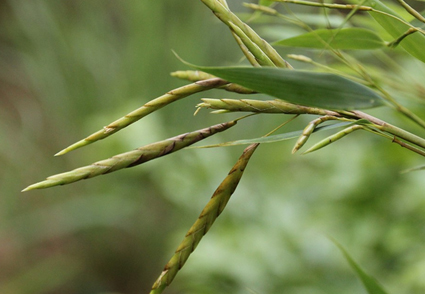Abstract
Acidosasa gracilis was treated as a synonym of Acidosasa breviclavata in the account of Acidosasa in Flora of China. However, after field study and examination of herbarium specimens, it is concluded that A. gracilis and A. breviclavata are two distinct species. Thus, the name Acidosasa gracilis is reinstated in this study. Besides, this research confirmed that Sinobambusa sulcata is a synonym of A. gracilis, rather than Oligostachyum scabriflorum. A colour plate of A. gracilis and notes on comparison between this species and the morphologically similar species are also provided.
References
- Beentje, H. (2016) The Kew Plant Glossary. Second edition. Royal Botanical Gardens, Kew, London, 184 pp.
- Cai, Z.Y. & Xia, N.H. (2021) The floral morphology of Ferrocalamus rimosivaginus (Poaceae: Bambusoideae). Phytotaxa 498 (4): 265–272. https://doi.org/10.11646/phytotaxa.498.4.4
- Chu, C.D. & Chao, C.S. (1979) Acidosasa, a new genus of Chinese Bambusoideae. Journal of Nanjing Technological College of Forest Products 1: 142–145.
- Harris, J.G. & Harris, M.W. (2001) Plant Identification Terminology: an illustrated glossary. Spring Lake publishing, Payson, 302 pp.
- Hickey, M. & King, C. (2013) The Cambridge Illustrated Glossary of Botanical Terms. Cambridge University Press, Cambridge, 208 pp.
- Keng, P.C. (1982) A revision of the genera of bamboos from the world (II). Journal of Bamboo Research 1 (2): 31–46.
- Li, D.Z., Wang, Z.P., Zhu, Z.D., Xia, N.H., Jia, L.Z., Guo, Z.H., Yang, G.Y. & Stapleton, C. (2006) Tribe Bambuseae In: Wu, Z.Y., Raven, P.H. & Hong, D.Y. (Eds.) Flora of China, vol. 22. Science Press, Beijing & Missouri Botanical Garden Press, St. Louis, pp. 7–180.
- Lin, W.T. (1986) Some new plants of Bambusoideae from Guangdong. Bamboo Research 2: 22–27.
- Lin, W.T. (1988) New taxa and combinations of Bambusoideae from China. Acta Phytotaxonomica Sinica 26 (2): 144–149.
- Lin, W.T. & Wu, Z.M. (1992) Some new species of the bamboos from south China. Journal of Bamboo Research 11 (1): 27–37.
- McClure, F.A. (1940) New genera and species of Bambusaceae from eastern Asia. Lingnan University Science Bulletin 9: 1–67.
- Triplett, J. & Stapleton, C. (2010) Phylogeny of the temperate bamboos (Poaceae: Bambusoideae: Bambuseae) with an emphasis on Arundinaria and allies. Systematic Botany 35: 102–120. https://doi.org/10.1600/036364410790862678
- Turland, N.J., Wiersema, J.H., Barrie, F.R., Greuter, W., Hawksworth, D.L., Herendeen, P.S., Knapp, S., Kusber, W.H., Li, D.Z., Marhold, K., May, T.W., McNeill, J., Monro, A.M., Prado, J., Price, M.J. & Smith, G.F. (2018) International Code of Nomenclature for algae, fungi, and plants (Shenzhen Code) adopted by the Nineteenth International Botanical Congress Shenzhen, China, July 2017. Regnum Vegetabile 159. Glashütten: Koeltz Botanical Books. https://doi.org/10.12705/Code.2018
- Vorontsova, M.S., Clark, L.G., Dransfield, J., Govaerts, R. & Baker, W.J. (2016) World Checklist of Bamboos and Rattans. INBAR, Beijing & Royal Botanic Gardens, Kew, 459 pp.
- Wang, Z.P. & Stapleton, C. (2006) Oligostachyum. In: Wu, Z.Y., Raven, P.H. & Hong, D.Y. (Eds.) Flora of China, vol. 22. Science Press, Beijing & Missouri Botanical Garden Press, St. Louis, pp. 127–132.
- Wang, Z.P. & Ye, G.H. (1982) Oligostachyum-a new genus of Chinese Bambusoideae. Journal of Nanjing University (Natural Sciences) 1: 95–101.
- Xia, N.H. & Lin, R.S. (2009) Acidosasa. In: Wu, T.L., Hu, Q.M. & Chen, Z.Y. (Eds.) Flora of Guangdong, vol. 9. Guangdong Science and Technology Press, Guangzhou, pp. 286–288.
- Yang, B.M. (1981) A new species of Acidosasa from Hunan. Journal of Hunan Teachers’ College, Natural Science Edition 2: 53–55.
- Zheng, Q.F., Lin, Y.M. (1995) Bambusoideae. In: Lin, L.G. & Zhang, Y.T. (Eds.) Flora Fujianica, vol. 6. Fujian Science Technology Publishing House, Fuchou, pp. 29–96.
- Zhu, Z.D., Yang, G.Y. & Stapleton, C. (2006) Acidosasa. In: Wu, Z.Y., Raven, P.H. & Hong, D.Y. (Eds.) Flora of China, vol. 22. Science Press, Beijing & Missouri Botanical Garden Press, St. Louis, pp. 106–109.


